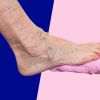Leg cramps - what are they and what causes them?

Leg cramps are a condition that can have a varied origin. The diagnosis of its cause depends mainly on the accompanying symptoms, but also on gender, age, diet and lifestyle.
In the vast majority of cases, leg cramps are an indication of a mineral deficiency, the use of weight loss products or an injury such as a strain.
Limb muscle cramps should not be underestimated, as they can accompany serious diseases, including diabetes, hypertension and thrombosis. Swelling and bruising of the legs occurring together with strong muscle cramps should cause us particular concern.
Leg cramps and mineral deficiency
The most common and at the same time the most prosaic cause of muscle cramps is a mineral deficiency, mainly magnesium and potassium. Night muscle cramps are a symptom of acid-base imbalance in the body and negatively affect the quality of life.
In such a situation, it is recommended to give up or significantly reduce the intake of coffee and beverages containing caffeine. This is important because caffeine leaches vitamins and minerals.
Apart from that it is worth taking dietary supplements rich in magnesium and potassium and implementing a properly balanced diet. Precious sources of magnesium are: dark cocoa, dark chocolate, cheeses, kefirs, natural yoghurts, fish (tuna, mackerel, cod and salmon), dark bread, buckwheat groats and cereals.
In addition, it is worth including vegetables rich in magnesium into your diet, including: spinach, kale, chard, peas, beans and chickpeas. In turn, potassium is contained in: lentils, parsley, nuts (especially pistachios), coconut shavings, turkey breast meat, beef and sirloin.
Leg cramps and strain
Leg cramps with accompanying pain are often the result of overexertion, e.g. from too much physical activity. They can also be the result of strength training without prior muscle warm-up.
In this case, it is a good idea to massage your legs and stretch your muscles. Painkillers, preferably non-steroidal anti-inflammatory drugs (NSAIDs), may also be taken temporarily.
Leg cramps and diabetes
Leg cramps are often one of the first worrying symptoms of diabetes. If they are particularly troublesome and accompanied by: increased thirst, frequent urination, weight loss or on the contrary, excessive sleepiness, uncontrolled hunger attacks, visual disturbances and badly healing wounds, you should go for a consultation with your primary care physician.
If diabetes is suspected, a fasting blood sugar test and a glucose intolerance test should be carried out. The treatment of diabetes and its accompanying symptoms, including leg cramps, depends on the type of diabetes, among other things.
However, in each case, it is necessary to change the current lifestyle - limit sugar and engage in physical activity.
Leg cramps and thrombosis
Muscle cramps are a characteristic symptom of thrombosis, however, they are usually accompanied by dull pain of a moderate nature, swelling, warming of the limbs, as well as an elevated body temperature.
In the early stages, the symptoms of thrombosis are not too bothersome, however, they should not be underestimated, as they are associated with an increased risk of pulmonary embolism.
Thrombosis is caused by the formation of thrombi that significantly impede or completely block the blood flow. The basis for diagnosis of this disease is Doppler ultrasonography (USG Doppler) and examination of the blood flow in the veins.
Treatment of thrombosis should be two-pronged and include both physical and pharmacological modalities. The former includes anticoagulant tights and elastic bands. Their effectiveness depends primarily on the selection of an appropriate size.
In the case of very strenuous cramps, the legs should be massaged, and a simple technique involving raising the legs 15 cm in a lying position (it is important that they are above the line of the heart) should be used.
On the other hand, among the pharmacological means of treating thrombosis we can mention: unfractionated heparins, low molecular weight heparins and vitamin K antagonists.
Leg cramps and hypertension
Muscle cramps often accompany hypertension, which is defined as blood pressure above 140 mm Hg systolic and 90 mm Hg diastolic.
In most cases, hypertension is idiopathic, meaning that its direct cause is unknown.
Importantly, hypertension is very often completely asymptomatic or sparsely symptomatic with: muscle cramps, feelings of restlessness, excessive sweating, hyperactivity, palpitations and tinnitus. Possible causes of hypertension are:
- Cigarette smoking;
- Obesity;
- Alcohol abuse;
- Use of anticoagulants;
- Disorders of the lipid and acid-base balance of the body;
- High-sodium, high-protein and high-fat diets;
- Long-term use of oral contraceptives.
Treatment of hypertension consists mainly in reducing or eliminating risk factors (quitting cigarettes, changing diet and lifestyle, stopping contraceptive pills).
In addition, pharmacological agents are used to lower blood pressure and thus minimise the risk of life-threatening complications.
Bibliography:
- Maździarz A., Venous thromboembolism - epidemiology and prevention. Current Gynecologic Oncology. 2015; 13: 191-200.
- Frank M., Sack M.D., Campos H., Treatment in hypertension. Cardiology after Diploma. 2010; 10: 12-25.



















